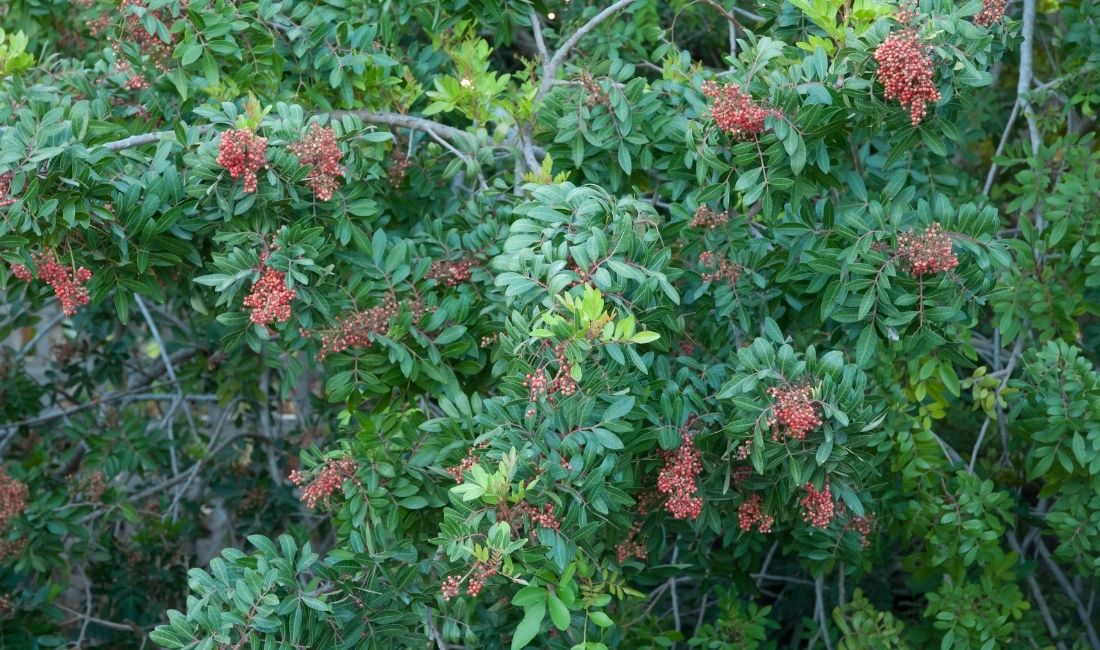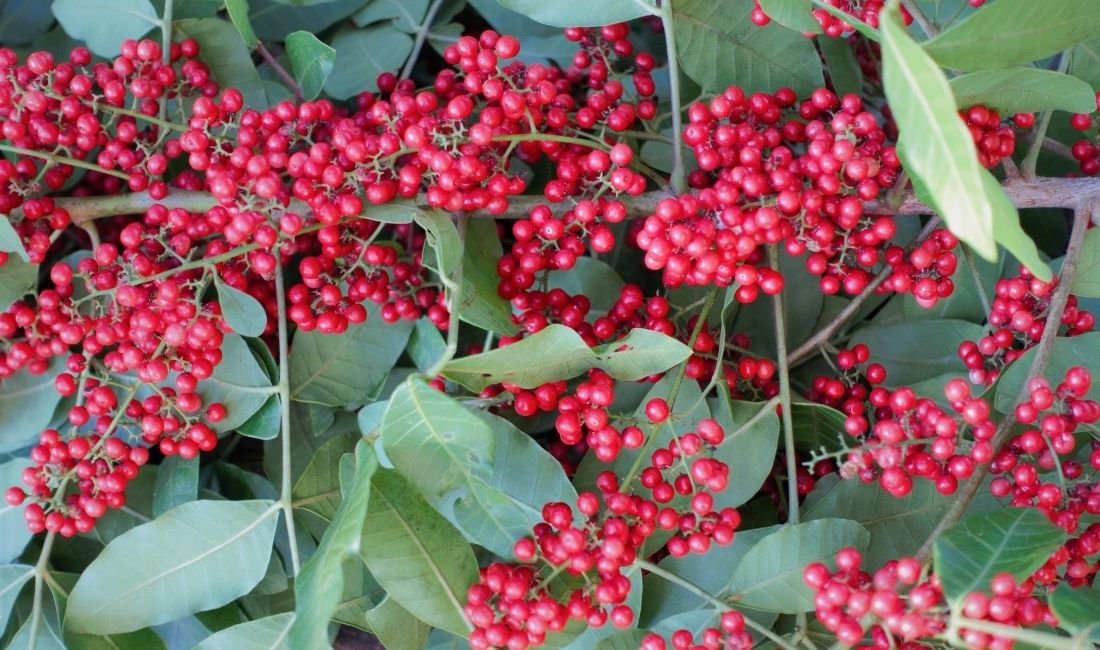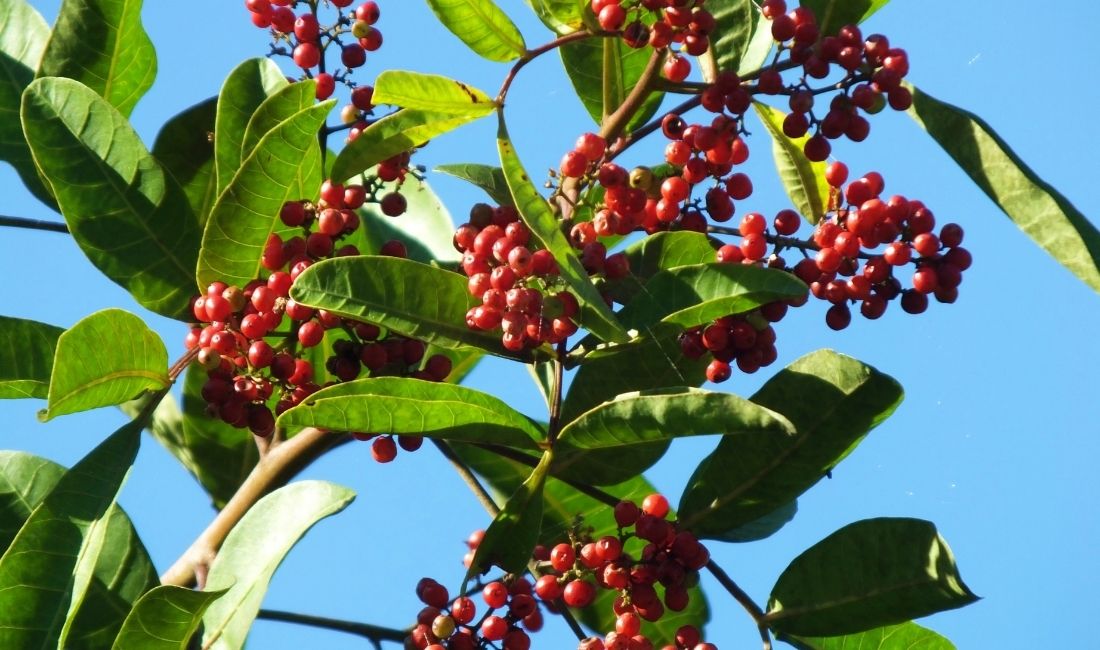Palm Beach may be known for its pristine landscapes, but that doesn’t mean it’s immune to invasive species. Plants like the air potato vine are already damaging our native ecosystems, but few are as aggressive or destructive as the Brazilian pepper tree.
This fast-spreading tree has been linked to millions of dollars in environmental damage, can poison pets, livestock, and wildlife that feed on its berries, and is still expanding across Florida at an alarming rate. Even well-maintained properties aren’t completely safe from its reach.
Key Takeaways:
-
Learn how the invasive Brazilian pepper tree was first introduced to Florida and why it quickly spread across the state.
-
Understand why the tree was eventually banned, including its harmful impact on native ecosystems and its toxicity to animals.
-
Discover the common problems associated with Brazilian pepper trees, such as severe allergic reactions and aggressive growth.
-
Find out how to properly identify a Brazilian pepper tree based on its distinctive leaves, berries, and growth patterns.
-
Get expert advice on what to do if you find one of these invasive trees on your property, including safe removal methods.
-
Explore alternative plants you can use to achieve a similar aesthetic in your landscape without the ecological risks of “Florida holly.”
About the Brazilian Pepper Tree
Brazilian pepper trees (Schinus terebinthifolia) are evergreens that are grown as a shrub or short tree. Sometimes spelled as Brazilian pepper-tree or Brazilian peppertree, they are most easily recognized by their fruit, which looks like bright red berries. Brazilian pepper tree foliage is often used as a Christmas decoration, which is why it is sometimes known by the names “Christmas berry, “Florida Holly,” or the “Christmasberry tree.”
But here’s the important part:
The Brazilian pepper tree is not a holly tree.
It’s not related to native Florida hollies (Ilex species), even though the nickname “Florida holly” makes it sound like it is. Unlike true holly, which can be a great addition to your landscape, the Brazilian pepper tree is invasive and harmful to Florida’s environment.
Are Brazilian pepper trees illegal in Florida?
Brazilian pepper trees are considered a Class I prohibited invasive species in Florida, which means it’s illegal to sell or plant. Once it shows up in your yard, it can be very hard to get rid of. The roots spread quickly, and the tree often grows back even after cutting it down.

How did the Brazilian pepper tree get to Florida?
Like many invasives, these trees were imported from their natural habitat. Originally from South America, they were brought to Florida and other southern states in the 1840s. It was brought as an ornamental and was celebrated because of the numerous red berries produced throughout the winter months. Despite its name, it is not only naturally found in Brazil but also in Paraguay, Argentina, and Uruguay.
How the Brazilian Pepper Tree Spreads
After being introduced to Florida in the 19th century as an ornamental plant, the Brazilian pepper tree quickly became a serious problem – mainly because of how easily it spreads.
Local Spread
Brazilian pepper trees produce large clusters of bright red berries that are highly attractive to birds and small animals. After eating the fruit, these animals disperse the seeds in their droppings, often far from the original tree. New trees can quickly sprout in disturbed areas, fencerows, drainage ditches, and even cracks in pavement.
The tree also spreads aggressively by root suckers, meaning it can send up new shoots from its root system – even if the main trunk is cut down. This makes it extremely hard to eliminate once it’s established.
Long-Distance Spread
In addition to being naturally spread by wildlife, Brazilian pepper trees have also been moved – intentionally or accidentally – by people. In the past, they were sold in garden centers or shared between homeowners before the plant was fully recognized as invasive. Even now, some people still unknowingly plant or keep them because they resemble harmless ornamental plants like native holly.
Why is the Brazilian pepper tree now banned?
It is Prolific
The Brazilian pepper tree was not officially recognized as an issue in the state of Florida until the 1960s. In the more than one hundred years since it was introduced, it’s now estimated to cover more than 700,000 acres in Florida alone. It does especially well in the southern areas of Florida, where cold weather and frost are less likely.
It Prevents the Growth of Native Species
Like other invasive species, as this tree grows, it prevents native plants from growing near it. Its canopy is so dense that the shade deters any plants from growing beneath it.
The “Florida Holly” quickly grows outside of areas where it was intentionally planted thanks to the distribution of its seeds by birds and other animals that eat the fruit. Raccoons, opossum, robins, cedar waxwings, northern mockingbirds, and gray catbirds have been known to eat the fruit and thus start new plantings.
It Can Harm or Kill Wildlife
While it may sound like a positive thing that the tree is providing food to animals, there is a caveat. If birds, for instance, only eat berries from the Brazilian pepper tree and nothing else, they are likely to die. In fact, scientists have noticed a decline in native robin populations in Florida because of this tree.
It Harms Agriculture and Livestock
Any time that areas of land are cleared for development, the Brazilian pepper tree takes advantage of the bare area and can quickly take over. Florida is one of the largest suppliers of cattle, specifically beef cattle. When the Brazilian pepper tree sprouts in the open grazing fields, cows often eat it and become sick or die. Many landowners and ranchers in Florida are spending extreme amounts of money yearly to remove this invasive plant from their properties to prevent losses of their livestock and agriculture.
It Harms Florida’s Ecosystem
Because it prevents other plants from growing, it replaces healthy ecosystems with a monoculture. While a variety of native plants and trees is a sign of a healthy ecosystem, a surplus of one plant (especially a non-native one) is a sign of an unhealthy area. This leads to even more problems.

What problems might you encounter with the Brazilian pepper tree?
Skin Irritation
On top of the Brazilian pepper tree’s invasive qualities, this tree or shrub has leaves and sap that can irritate your skin. Because it is in the same family as poison ivy and poison oak, reactions can include severe skin irritation.
Breathing Problems / Allergic Reactions
It’s also related to pistachios, cashews, and mangos, so if you have an allergic reaction to any of those foods, you may have some respiratory or allergy issues if you are near the tree. In this instance, you don’t even need to have contact with the tree for these breathing problems to occur.
Are Brazilian pepper trees toxic to dogs?
Yes, Brazilian pepper trees are considered toxic to dogs and other pets.
The leaves, bark, and especially the berries contain compounds that can irritate a dog’s digestive system and cause other health issues. If your dog chews on or ingests any part of the plant, they may experience symptoms such as:
-
Vomiting
-
Diarrhea
-
Drooling
-
Mouth or throat irritation
-
Loss of appetite
-
Lethargy or weakness
In some cases, skin contact with the sap may also cause rashes or allergic reactions, especially in dogs with sensitive skin.
If you suspect your dog has eaten part of a Brazilian pepper tree, it’s best to contact your veterinarian immediately.
Because these trees are so widespread in Florida, pet owners should be especially cautious when walking dogs near overgrown areas or natural preserves where these invasive trees are common.

How To Recognize A Brazilian Pepper Tree
Size and structure
At its full size, the Brazilian pepper tree can grow up to 33 feet tall and around 20 feet wide. The branches intertwine and normally hide the trunk from view.
Leaves and leaflets
The dark green leaves are oblong and sometimes have a reddish midrib. There are several leaflets on a leaf, usually 3 to 13, and the leaflets are each 1 to 2 inches long.
When very young, the sapling will have sets of leaves with 3 leaflets – two across from each other and one growing perpendicular. As the tree grows, more leaflets will be added, but always with 2 leaves across from each other and an odd one pointing out.
Young trees have leaves with serrated edges. The edges smooth out as the tree grows.
Flowers and fruit
The tree flowers from September through November in Florida, and the fruits mature by December. The flowers are small and white, and the fruit is green and glossy but matures to a bright red and can become up to 2.4 inches wide. The fruit is technically a drupe but is also called a berry.
They are so common in Florida that you have probably seen many Brazilian pepper trees without knowing it. Look for them in areas where birds congregate. They also like to grow among other bushes, sneakily growing and then overtaking the native plants over time.

How to Kill a Brazilian Pepper Tree
If you have a Brazilian pepper tree on your property, we recommend that you have it removed immediately. The trunk may also need to be treated with herbicide to prevent regrowth. If possible, the roots should be removed for the same reason.
Removing a Brazilian pepper tree can be a time-consuming process, thanks to the tangle of intertwining branches and the tree’s allergenic properties. Be sure to keep the berries away from wildlife as you remove the tree to prevent new saplings from appearing. We recommend throwing the berries away (do not compost them).
It’s easier to remove a Brazilian pepper tree while it is small, so keep an eye out for this invasive seedling and remove it as soon as possible!
Wild Floridian has a great video where she demonstrates how to recognize and remove Brazilian pepper trees.
The state of Florida has spent millions of dollars trying to control the spread of this invasive tree due to its negative impact on the state, wildlife, agriculture, and residents. Removing any Brazilian pepper trees from your property can help fight this invasion.
Did You Know?
A tiny wasp could be slowing the spread of this invasive tree!
The Megastigmus transvaalensis, a seed wasp originally from South Africa, lays its eggs inside the tree’s developing seeds. As the larvae grow, they destroy the seeds from the inside – preventing them from sprouting into new trees.
While this natural predator can reduce seed viability by up to 90%, it’s not a complete solution. Professional removal and herbicide treatment are still the most effective ways to control established trees.

What can I plant instead of a Brazilian pepper tree?
While some people mistakenly refer to the Brazilian pepper tree as “Florida holly,” it’s not a holly tree at all. In fact, Florida is home to several true native holly species, including:
- Dahoon holly (Ilex cassine)
- Nativa Dahoon (‘Nativa’)
- Tensaw Dahoon (Ilex cassine ‘Tensaw’)
- Myrtle-leaved holly (Ilex cassine var. myrtifolia)
- Gallberry or inkberry (Ilex glabra)
- Compact gallberry ‘Compacta’
- Nigra gallberry ‘Nigra’
- Krug’s holly (Ilex krugiana)
- American holly (Ilex opaca)
- Dwarf yaupon holly ‘Nana’
- Schellings holly ‘Schellings Dwarf’
- Taylor’s Rudolph dwarf yaupon ‘Taylor’s Rudolph’
Learn more about Florida hollies in this table from the University of Florida Extension.
If you enjoy the Brazilian pepper tree because of the nectar it provides for bees, consider planting a Firebush instead.
And if you like the look of the Brazilian pepper tree, consider natives such as Dahoon Holly (Ilex cassine) or Simpson’s Stopper, also known as twinberry (Myrcianthes fragrans).

Trust Coastal Gardens to Protect Your Landscape from Invasive Threats
In well-maintained areas like Palm Beach, it’s easy to assume that invasive plants like the Brazilian pepper tree aren’t an issue. And while that may be mostly true, no property in Florida is completely immune – especially with how easily these trees can spread through wind, birds, or nearby unmanaged lots.
The best way to ensure your landscape stays healthy, beautiful, and protected is with the help of experienced professionals who know what to look for. At Coastal Gardens, we maintain pristine outdoor spaces and stay vigilant for invasive species, noxious weeds, and early signs of trouble that could disrupt the balance of your landscape.
Call Coastal Gardens today at 561-308-7604 or schedule an appointment online to enjoy peace of mind, knowing your landscape is in expert hands.
CALL US TODAY At 561-308-7604
Estate landscape Services
For Fine Properties in Palm Beach
With Coastal Gardens, you can rest easy knowing that your property is taken care of by a dedicated team of estate landscape professionals who truly care about creating and maintaining a dazzling outdoor space you can be proud of.
